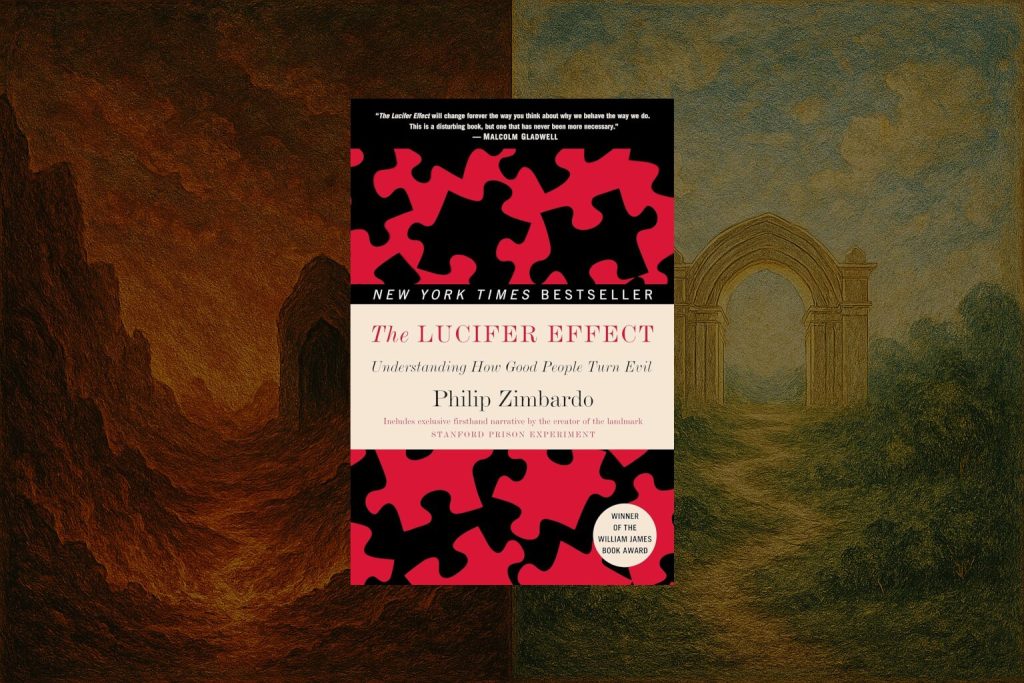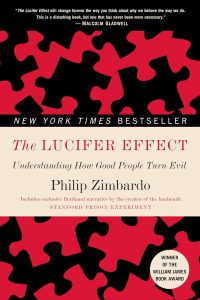
Welcome to my monthly book recommendation for April! Every month, I recommend a book that I’ve personally read and find worthwhile enough to recommend to my own readers. In each post, I’ll introduce the book, discuss why I found reading it worthwhile, and the major themes the book touches upon. I won’t include any major spoilers, but I may discuss some of the characters and specific details or locations from within the book.
My recommendation for April 2025 is Philip Zimbardo’s The Lucifer Effect.
The Lucifer Effect: Understanding How Good People Turn Evil
Available on Amazon
 Authors: Philip Zimbardo
Authors: Philip Zimbardo
Genre: Non-fiction
Description:
This is a book that dares to hold a mirror up to mankind, showing us that we might not be who we think we are. While forcing us to reexamine what we are capable of doing when caught up in the crucible of behavioral dynamics, though, Zimbardo also offers hope. We are capable of resisting evil, he argues, and can even teach ourselves to act heroically. Like Hannah Arendt’s Eichmann in Jerusalem and Steven Pinker’s The Blank Slate, The Lucifer Effect is a shocking, engrossing study that will change the way we view human behavior.
My Thoughts
The Lucifer Effect is comprised of two major sections: a first-person delineation of the events that took place during the Stanford Prison Experiment, followed by a detailed analysis of the American atrocities committed in the Abu Ghraib prison during the early 2000s with a focus on how they relate with the findings of the Stanford Prison Experiment. The author, Philip Zimbardo, is uniquely qualified to present this content, especially that of the first major section, as he is not only the creator of this experiment, but also the person who terminated it prematurely, at the behest of his future wife, Christina Maslach.
The Stanford Prison Experiment was a highly controversial experiment on psychology. In August of 1971, twenty-four male college students entered a realistic mock prison environment, complete with cells, beds, and a distinct lack of windows and clocks. They were randomly split into two groups: the guards and the prisoners. The guards took shifts while the prisoners stayed full-time. The subsequent events unfolded so quickly and forcefully, Zimbardo and his assistants, as well as the mock guards and prisoners, found themselves continuously readjusting to adjust to the ever-changing norms and personality developments. Everyone involved, including Zimbardo himself, found themselves exhibiting personality traits they’d never thought possible of themselves. The guards’ behavior quickly transformed from relatively benign teasing and small exertions of power to gross mishandling and abuse of the prisoners. Each individual psychologically became that which they were pretending to be, all in the course of hours and days.
Over time, the experiment gained both notoriety and infamy. Its findings have slowly helped to influence policy and public perception of the impact of dispositional tendencies as compared to situational, or environmental influences upon individuals, and to what degree perpetrators of atrocities should be held responsible vs. those who created the situations that made them possible. However, subsequent experiments have attempted to reproduce the findings but have found limited success. Today, the experiment is considered to be only partially valid – methodological flaws, such as behavior priming of the guards, unduly influenced the results of the experiment. However, in my opinion, this doesn’t significantly change the lessons we can learn from the experiment. Even if the guards were influenced to take the actions they took, they ultimately still took them. Even if the selection of participants was not sufficiently diverse, we can at least see how at the very least, a non-diverse population can culturally degrade into deplorable behaviors and social norms under non-ideal circumstances.
When we think of oppression and genocide, we typically think back to Nazi Germany, thinking “this could never happen here, to us.” That opinion is common, even natural, but is also extremely foolish and naïve. This book delves into the atrocities committed by American soldiers in the early 2000s – not soldiers from another place in time from another nation enveloped in another culture, but our own soldiers (if you’re an American reading this) in this modern era. American soldiers rounded up Iraqi citizens with little to no evidence of wrongdoing, imprisoned them in filthy, sub-human living conditions, and tortured them for their own amusement. This is not an exaggeration. The Americans involved showed no prior signs of psychopathy, criminal behavior, or anything else that would predict their participation in the atrocities they’d committed.
At the surface, this book offers a psychological analysis of human behavior in stressful, ambiguous circumstances and proves that environmental factors have at least as much influence on evil behavior as dispositional attributes. At a much deeper level, this book serves as a stern warning that atrocities such as those that took place in Abu Ghraib, Nazi concentration camps, Japanese internment camps in WWII America, and countless other examples aren’t caused by a few “bad apples,” they’re caused by systematic diffusion of responsibility, poor leadership, and a general lack of accountability – the few are blamed by the situational circumstances collectively caused by the many.